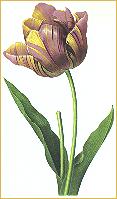Tulip
|
|
- This article is about the Tulip bulb plant. For the Tulip-tree, see Liriodendron. For the Tulip computer company, see Tulip Computers NV.
| Tulip | ||||||||||||
|---|---|---|---|---|---|---|---|---|---|---|---|---|
| Missing image Wild_tulip_in_the_steppe_of_Kazakhstan.jpg Wild tulip in the steppes of Kazakhstan | ||||||||||||
| Scientific classification | ||||||||||||
| ||||||||||||
| Species | ||||||||||||
|
See text |
Tulips are plants of the genus Tulipa, in the lily family, Liliaceae. They are bulbous plants, with large, showy flowers with six petals. There are around 100 species, originating from the region from southern Europe, north Africa, and Asia from Anatolia and Iran east as far as northeast China and Japan. The centre of diversity of the genus is in the Pamir and Hindu Kush mountains and the steppes of Kazakhstan.
The tulip is the national flower of Iran and Turkey, and tulip motifs feature prominently in Persian and Turkish folk arts. The European name for the flower is a misuse of the Persian word for turban, a mistake probably originating in the common Turkish custom of wearing flowers in the folds of the turban.
Unofficially, the flower is also emblematic of Netherlands. For instance, in an annual gesture of gratitude to Canada for liberating the nation from Nazi German tyranny in World War II, a supply of tulips is sent to be planted in Canada's national capital in Ottawa.
In both the Ottoman Empire and Netherlands, separate episodes of tulipomania struck both countries which both led to damaging speculation crashes which also contributed to the Ottoman Empire's financial decline.
Numerous cultivars have been bred for garden use. It is often considered one of humanity's "canonical flowers", along with the rose, lily, orchid, and peony (see Pollan).
History of cultivation
To whom the credit belongs for bringing the flower to northwest Europe is unclear. The most widely accepted story is that of Oghier Ghislain de Busbecq, Ambassador from Ferdinand I to Suleyman the Magnificent in 1554. He remarks in a letter upon seeing "an abundance of flowers everywhere; narcissus, hyacinths, and those which the Turks call tulipam, much to our astonishment, because it was almost midwinter, a season unfriendly to flowers" (see Busbecq, qtd. in Blunt, 7). However, this account can be called into question. Tulips do not flower in midwinter even in the warmer climates of the Middle East, and therefore Busbecq (who wrote and dated his letters as a collection after his expedition) must have been misremembering the date of a journey he took through the same area in 1558. However, by 1559, an account was given by Conrad Gessner of seeing tulips flowering in the garden of Councilor Herwart in Augsburg, Bavaria. Due to the very nature of the tulip's growing cycle, if the bulbs are to be removed from the ground, it generally occurs in June, and they must be replanted again by September to endure the winter, Busbecq's account of the supposed first sighting of tulips by a European is likely spurious. While possible, it is doubtful that Busbecq could successfully have had the tulip bulbs removed, shipped, and replanted between his first sighting of them in March 1558 and Gessner's description in 1559. Another oft-quoted account is that of Lopo Vaz de Sampayo, governor of the Portuguese possessions in India. Having been brought home in disgrace after usurping his position from the rightful governor, Sampayo supposedly took tulip bulbs with him from Sri Lanka. This tale too, however, does not hold up to scrutiny; tulips do not occur in Sri Lanka, and the island itself is far from the route Sampayo's ships should have taken.2005-04-08.FH-616.Tulip.jpg
Regardless of how the flower originally arrived in Europe, its popularity soared quickly. Carolus Clusius is responsible for much of the spread of tulip bulbs in the final years of the 1500's. The author of the first major work on tulips, finally completed in 1592, Clusius had already begun to note and remark upon the diseased variations in color that made the tulip so admired. Clusius' taste for tulips quickly spread to others. While occupying a chair in the medical faculty of the University of Leiden, Clusius planted both a teaching garden and his own private plot with tulip bulbs. In 1596 and 1598, however, Clusius suffered thefts from his garden, with over a hundred bulbs stolen in a single raid. Between 1634 and 1637, the early enthusiasm for the new flowers triggered a speculative frenzy now known as the tulipomania. The Netherlands and tulips are still associated with one another. The term 'Dutch tulips' is often used for the cultivated forms. Tulip Festivals are held in the Netherlands and in North America every May.
Tulips cannot be grown in the open in tropical climates, as they require a cold winter season to grow successfully. Manipulation of the tulip's growing temperature can, however, allow growers to "force" tulips to flower earlier than they normally would.

Some historical cultivars have had a striped, "feathered", "flamed", or variegated flower, as in the illustration. While some modern varieties also display multicolored patterns, this results from a natural change in the upper and lower layers of pigment in the tulip flower. Historical variegated varieties- such as those admired in the Dutch tulipomania gained their delicately feathered patterns from a viral infection. The mosaic virus is carried by peach potato aphids, Myzus persicae, an insect common in European gardens of the seventeenth century, in which peach trees were often a prominent feature. While the virus produces fantastically beautiful flowers, it also causes the plant to sicken and die slowly. Today, it has been almost completely eradicated from growers' fields. The Black Tulip was the title of a historical romance by Alexandre Dumas (1850), in which the city of Haarlem has a reward outstanding for the first grower who can produce a truly black tulip. This fascination with growing a black tulip, a task biologically impossible, was historically accurate to the tulipomania in which the novel is set.
Tulip_inside.jpeg
Tulips can be grown in either of two ways: through offsets or seed. Being genetic clones of the parent plant, offsets are the only way to enlarge the stock of a given tulip cultivar. By contrast, tulips do not come true from seed; the mixing of genes between parent tulips is very unpredictable. A tulip grown from seed will usually bear only a passing resemblance to the flower from which the seeds were taken. This makes for great potential in breeding new tulip flowers, and great variation in the wild. However, tulip growers must be patient: offsets often take at least a year to grow to sufficient size to flower, and a tulip grown from seed will not flower for anywhere between five and seven years after planting. "Broken" tulips (tulips affected by the mosaic virus) will occasionally revert to plain "breeder" coloring, but usually maintain their colorful, infected state when grown from offsets.
Tulipa_liniifolia2.jpg
Species
About 100 species, including:
- Tulipa agenensis
- Tulipa armena
- Tulipa aucheriana
- Tulipa biflora
- Tulipa borszczowii
- Tulipa butkovii
- Tulipa carinata
- Tulipa celsiana
- Tulipa clusiana
- Tulipa cretica
Tulipa_praestans0.jpg
- Tulipa cypria
- Tulipa dasystemon
- Tulipa didieri
- Tulipa dubia
- Tulipa edulis
- Tulipa ferganica
- Tulipa gesneriana
- Tulipa goulimyi
- Tulipa greigii
- Tulipa grengiolensis
- Tulipa heterophylla
- Tulipa hoogiana
- Tulipa humilis
- Tulipa iliensis
- Tulipa ingens
- Tulipa julia
- Tulipa kaufmanniana
- Tulipa kolpakowskiana
- Tulipa kurdica
- Tulipa kuschkensis
Tulipa_turkestanica.jpg
- Tulipa lanata
- Tulipa lehmanniana
- Tulipa linifolia
- Tulipa marjolettii
- Tulipa mauritania
- Tulipa micheliana
- Tulipa montana
- Tulipa orphanidea
- Tulipa ostrowskiana
- Tulipa platystigma
- Tulipa polychroma
- Tulipa praecox
- Tulipa praestans
Tulipa_pulchella0.jpg
- Tulipa primulina
- Tulipa pulchella
- Tulipa retroflexa
- Tulipa saxatilis
- Tulipa sharonensis
- Tulipa sprengeri
- Tulipa stapfii
- Tulipa subpraestans
- Tulipa sylvestris
- Tulipa systola
- Tulipa tarda
- Tulipa tetraphylla
Illustration_Tulipa_sylvestris0.jpg
Flora von Deutschland, Österreich und der Schweiz 1885
- Tulipa tschimganica
- Tulipa tubergeniana
- Tulipa turkestanica
- Tulipa undulatifolia
- Tulipa urumiensis
- Tulipa urumoffii
- Tulipa violacea
References
Blunt, Wilfrid. Tulipomania.
Clusius, Carolus. A Treatise on Tulips.
Dash, Mike. Tulipomania.
Pavord, Anna. The Tulip.
Pollan, Michael. The Botany of Desire.
Template:Commonscy:Tiwlip
da:Tulipan (Tulipa)
de:Tulpen
eo:Tulipo
es:Tulipán
fr:Tulipe
it:Tulipa
lt:Tulpė
nl:Tulp
ja:チューリップ
zh:郁金香

